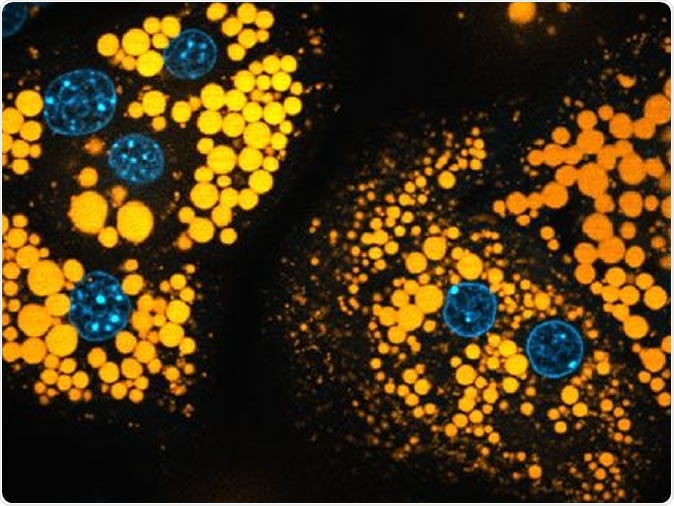Fats have earned a bad name as the source of all that is wrong with our hearts and blood vessels, not to mention our appearance. The dysfunctional handling of lipids or fats in the body is deeply involved in a multitude of metabolic upsets, such as obesity and cancer.
A new study from Bonn researchers published in the journal Nature Methods shows how they kept track of specially marked fat molecules as they passed through various metabolic processes in the body of a mouse, even within a single cell of the liver, without losing touch for even a short time. This could help track drug effects on fatty tissues within the body one day – helping develop new drugs without unnecessary toxicity.
Fat – a vital molecule for life
The association of fat with cardiovascular disease overlooks the obvious fact that fat is an integral part of the cell membrane, the delicate but robust and highly multifunctional layer that encloses each individual cell, keeping it healthy and yet providing abundant communication with neighboring cells and tissues. Fat is also the most efficient storage depot for energy in the human body, an excellent insulator reducing the body’s energy expenditure on keeping the temperature constant, and an extremely durable ‘bubble wrap’ for sensitive and relatively superficial organs like the kidneys. Fats make up the insulating myelin sheath around the long nerve fibers called axons, which make up nerve pathways. They are also the building blocks for dozens of vital compounds, including the all-important steroid hormone molecules that determine male and female characteristics, and the adrenal corticosteroids.
When fat metabolism goes awry in cancer patients, the characteristic cancer cachexia syndrome develops, with extreme weight loss despite normal food intake. Specific disruptions in fat metabolism can also cause neurological disease as the nerve cell membrane ceases to function normally.

Picture of liver cells that are full of fat droplets (orange). The cell nuclei are shown in blue. Image Credit: © K. Piotrowitz/AG Thiele
The experiment – and what they found
To understand the mechanisms underlying this type of disease process, scientists have long been looking for methods to tail one or more fat molecules through the entire metabolic pathway – from its uptake into the body up to the point where it is expelled. This requires finding a way to tag the fat molecule so that its progress can be monitored from point to point, rather like tracking a parcel on its delivery pathway. In earlier research, radioactive tags, fluorescent dyes, or heavy metal isotopes were used to mark fats so that they could be followed through the various metabolic processes that comprise the physiological pathway of a fat molecule.
They noted, however, that this type of tagging suffered from a lack of specificity. This meant that large amounts of the substance of interest needed to be tagged, and secondly, only a small fraction of the marked compound could finally be traced.
The current study demonstrates the use of a much more effective and highly sensitive technique that increases the number of successfully tracked fat molecules by a thousandfold. The researchers added a triple bond to the fat molecules they wanted to trace, making it an ‘alkyne’ lipid. These were then inserted in the mouse liver cells and the products of metabolism were allowed to attach to other tagging molecules, called “reporter” molecules. These were designed to ensure their visualization later on in the experiment. Mouse liver cells were used since the liver is where most fat metabolism occurs in the body.
The metabolic products derived from the fat molecules were then shot into impact with gas molecules inside a mass spectrometer, while they were being weighed. This caused their decomposition, forming specific byproducts which activated the reporter molecules, making them visible.
This step allowed the current experiment to detect the marked alkyne lipid molecules a thousand times more sensitively compared to the unmarked lipids; in addition, the detection occurs in minutes rather than hours.
Implications
Using this method, the researchers explain, about a hundred different types of lipids can be marked and traced down to cell level in the liver. Thus the normal process of metabolism can be tracked, as well as the abnormal. This could be extremely helpful when it comes to testing the effects of a new drug on lipid metabolism, and could also help to fine-tune new drugs to reduce such toxicities if present. Such side effects would probably be tested in cell cultures or organoid cultures.
The need for culture-based testing of drugs meant for human use is because the technique is limited when it comes to tracking fat molecules in human food, to examine human nutrition. Researcher Christoph Thiele says, “We still don't know exactly what the fatty acids coupled to alkyne groups do in the human body when they are ingested with food.”
Journal reference:
Multiplexed and single cell tracing of lipid metabolism, Christoph Thiele, Klaus Wunderling & Philipp Leyendecker Nature Methods (2019), https://www.nature.com/articles/s41592-019-0593-6